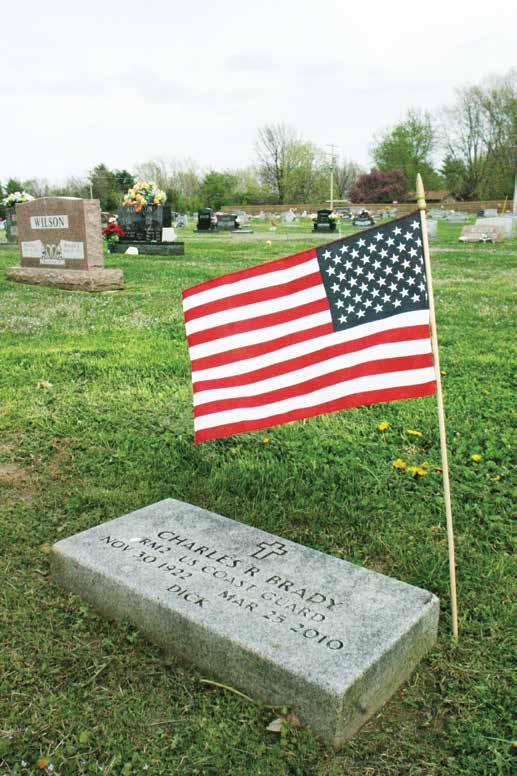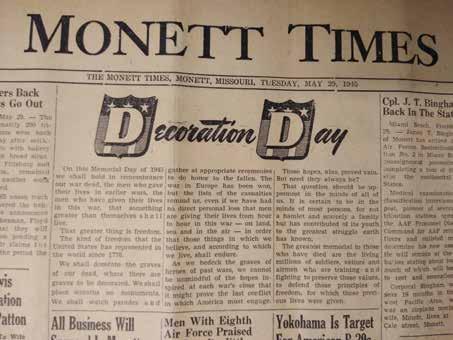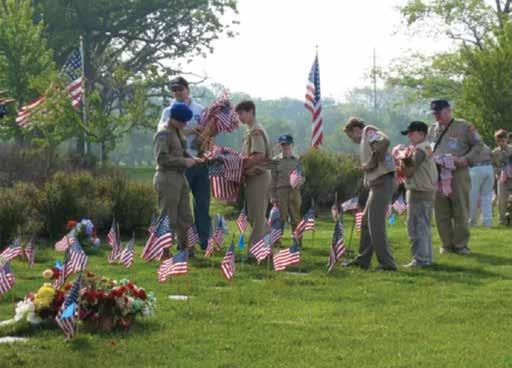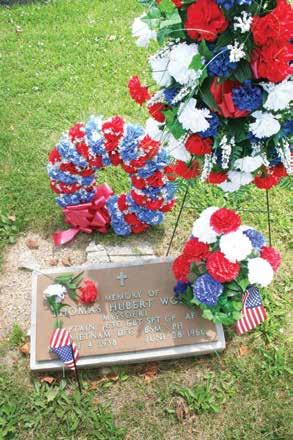
8 minute read
AMERICAN HEROES
HONORING AMERICA'S HEROES The grave for Dick Brady, Monett American Legion past commander, Coast Guard veteran, longtime editor and publisher at The Monett Times, in the Monett IOOF Cemetery, decorated for Memorial Day.
Memorial Day is one of the most special days on the American calendar, sacred for the honor it extends to war heroes, but secular in that it encompasses all who have served, regardless of religion or ethnicity. Different from Veterans Day, Memorial Day honors the dead and has evolved over time to a much more universal recognition.
Advertisement
Memorial Day began as Decoration Day. In one of the oldest surviving newspapers in Monett, The Monett Times printed General Order No. 1, dates May 23, 1901, from Eagle Post No. 492, Department of Missouri for the Grand Army of the Republic, which read "We are again reminded that the time is fast approaching when according to the well established custom of our order, it will be our sad duty by lovingly and earnestly duty [to] devote a day to our heroic dead, departed comrades whose record in this life is closed. Therefore it is earnestly requested that all comrades meet at the Post Hall at 1 p.m. Thursday, May 30, and march to the cemetery and there decorate the graves of Union soldiers with the flowers of spring and the flag they love so well."
The order went on to appeal to the city to suspend business from noon to 5 p.m. "so that all may have an opportunity to participate in this great and loving cause." Memorial services were held at the Methodist Episcopal Church South (Sixth and Bond) during the regular Sunday service on May 26. "All comrades should attend," said the order, signed by G.B. Draper, Post commander, and O.P. Shaffer, adjutant.
Memorial Day salutes military service
With the end of World War II in sight but with many local soldiers still on the front lines in both Europe and Asia, this was the notice for Memorial Day in 1945 in The Monett Times.
For the record, Decoration Day, honoring the war dead, started right after the Civil War in 1866 in both the North and South. The first edict starting a formal practice came from Maj. Gen. John "Black Eagle" Logan, then commander-in-chief of the GAR, on May 5, 1868.
Pierce City had both a GAR and a Confederate veterans organization. The two competed to see which group could mount the most impressive Decoration Day, according to newspaper accounts, and the Monett Federal veterans would travel to boost the GAR numbers. The Confederate veterans generally held their celebrations in April or earlier in May, a practice that varied by state. By 1900, the practice had mostly coalesced around May 30. By act of the U.S. Congress, Memorial Day was declared a national holiday in 1971, set for the last Monday in May.
After World War I, the recognition expanded to honor veterans of all wars. Monett seems to have begun having formal services on a much larger scale in 1946, not just in one cemetery, but in three. That year leading the occasion were members of the American Legion, Veterans of Foreign Wars, the National Guard, the War Dads made up of fathers of soldiers, women's auxiliaries for the veterans' groups, and the Monett High School Band. In 1947, Boy Scouts from Troops No. 140, 37 and 38 began helping to decorate the graves.

By 1948 the Monett effort encompassed four cemeteries: Oakdale, IOOF, Mt. Calvary and Waldensian. Glennon Bass headed the overall effort for the Legion. At the time, however, receiving a flag was restricted to persons who had died in the war, "according to flag etiquette," said Hope (Mrs. Phil) Bounous with the Legion Auxiliary.
The practice of placing a flag on the grave of all veterans seems to be an extension of the honor extended in national cemeteries. In Massachusetts state law it says: “In cities and towns where there are cemeteries containing the remains of deceased veterans, such cities and towns shall cause to be placed on such veterans’ graves a flag of the United States on every Memorial Day.”
According to Todd Burris, program manager for the law enforcement cadet program in the Americanism division for American Legion National Headquarters, some cemeteries get around the difficulty of identifying veterans' graves by putting flags on every grave, regardless of service. "Typically local posts perform this function independently from national headquarters," Burris said. "The Flag Code is silent on specification for display of flags on individual cemetery plots, regardless of the occasion. We defer to the policies of cemetery management on their discretion, regardless if the flag is in an American Legion holder or not."
The Legion does advise that flags used for display be picked up as soon as possible and not allowed to weather.
Glennon Bass, in charge of the flag distribution for Monett's American Legion Post in 1948, passed the responsibility of honoring vets on Memorial Day to fellow Legionnaire Bill Mitchell. In the 1980s, Mitchell asked Dayton Mackey to take over, who got help from Jon Suit. Dayton recalled originally the list of veterans was written on a piece of cardboard that the Legionnaires would carry with them. "It would get wet and you couldn't read it," he recalled. "We went all through the cemetery and made a better list."
The list had also grown. The names of 47 soldiers honored were listed in The Monett Times in 1948. Recognition of all veterans boosted the list by 51 Civil War veterans alone in the IOOF and Oakdale cemeteries. By 1988 the number was up to 540. Today, including five cemeteries, the number runs over 1,000. As of October 2019, that compares to 908 persons buried in Oakdale, 5,905 buried in IOOF and 125 in the Cox cemeteries.
Dayton recalled how he began helping provide flags for the cemetery at Arnhart Baptist Church, east of Purdy, while working with Charles D'Arcy to put out flags at the Waldensian Presbyterian Church cemetery. Roger Smith began taking flags to the Bethel Cemetery.
The Legion continues to decorate the entrance to the IOOF Cemetery, placing extra flags by the entrance for unidentified veterans' graves or ones missed in the distribution.
In 2005, the Pierce City Cemetery Association began writing down where people had placed flags. The list has since grown to around 450 identified veterans' graves. The Pierce City Ozark Legion Post No. 65 conducts that flag distribution, with additional volunteers.
Boy Scouts placing flags on graves of military veterans at the Veterans Memorial Cemetery in Union Grove, Wis., on Memorial Day. Photo by Gary Dikers, Wisconsin Department of Veterans Affairs.

Decorations placed on the symbolic gravesite for Thomas Wolfe, the namesake of the Tom Wolfe Memorial Post No. 4207, Veterans of Foreign Wars, in Monett, marked in a ceremony held on Memorial Day in the Monett IOOF Cemetery.

MEMORIAL DAY
Monday, May 25, 2020 for the Home of the Brave
On Memorial Day itself, Tom Wolfe VFW Post No. 4207 in Monett conducts a service at noon at a ceremonial gravesite for their namesake in the IOOF Cemetery. To date Wolfe's remains have not been recovered from Vietnam, though the location of his shot-down plane is believed to be known. This ceremony involves laying red, white and blue flowers and a wreath, symbolizing courage, devotion and sacrifice, and a 21-gun salute.
Around 2000, the City of Monett began converting its records to a computer database. Angie Irwin, who was then working in the Public Works department, gathered the books and cards collected at the IOOF Cemetery office and began entering the names, dates and locations, including details on when plots were purchased, into the city computer system. She walked the cemetery "two or three times" to craft a map of all three sections of the IOOF Cemetery, as well the former Cox family cemetery and the Oakdale Cemetery. Oakdale, originally the Westbay Cemetery, where the city's earliest Decoration Day services were held, had a monument erected by the GAR at the east entrance in 1912. The city acquired that cemetery in 1953 after it had fallen into neglect, and a committee wrestled it out of private hands.
Angie created maps for each cemetery, including separate books for each block. The books show row by row where the veterans are buried, highlighted in color. She would loan copies of the books each year to the Legion as guides for the family distribution.
Kristen Thompson has now taken over recording new burials in the city's records, and added names to the spreadsheet in the database. Each year, Angie said, funeral homes have updated the city on their burials, and staff have gone to websites of funeral homes to gather obituary information, including the names of immediate survivors, to add to the city's records. All the cemetery records are available online, making genealogical research much easier.
With few World War II veterans left, those who pushed for making Memorial Day a not-to-be-forgotten date have left the task to the next generation. Angie said with changing times, it has become more difficult to document family history information. Cremations, she noted, may not involve a funeral home. A death may be announced, stating "services at a later date," which never happen. In those cases, she said, there is no obituary to record. If a veteran is buried without a military marker, no one will know, she said.
But now, without having to rely on a previous flag distribution or a faded and stained piece of cardboard for names, the honorees of Memorial Day in the Monett area have been identified and located. Those who carry the flags on that Friday before Memorial Day conduct their task perhaps not with the heavy hearts of those who knew many of the buried veterans before joining them. These flag bearers go with pride, acknowledging the sacrifices of these ancestors, the ones who made this the "Land of the Free and the Home of the Brave." n




